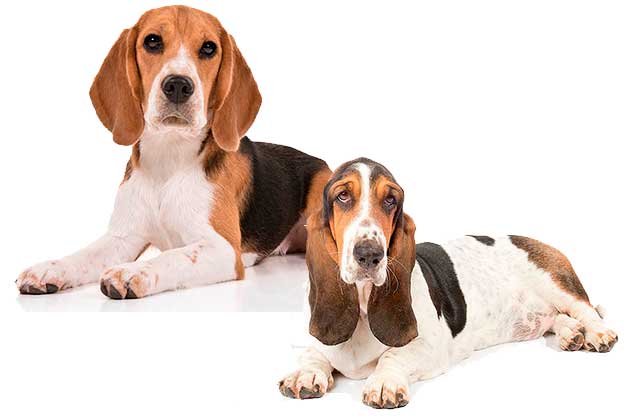These two scent hounds are quite similar in color and markings, and they are both very popular AKC breeds.
But you want to know more than who can win a popularity contest, don’t you?
Let’s take a closer look at the Beagle and the Basset Hound and decide which may be the better pet for you…Snoopy or Droopy?

History Of the Beagle and Basset Hound
The exact origin of the Beagle is the subject of much speculation. Some experts believe that they are an ancient breed of “foot hound” that hunters used in England before 55 B.C. to track hare while following on foot rather than on horseback.
Others believe that the Beagle is descended from the Talbot Hound, which was brought to Britain in the 11th century by William the Conqueror.
In fact, there is so much conjecture surrounding the beginnings of the breed that even the origin of its name is subject to debate.
Some say that it comes from the word, “Beagle,” which is Gaelic for “little,” while others believe that the Beagle’s name is derived from the old French word, “begeule,” which was used to refer to a noisy, shouting person.
Kinda sounds like, “bugle,” which would make sense…but again, this is all speculation.
Whatever the case, Beagles were first imported to the United States after the Civil War, becoming a much sought after breed amongst rabbit hunters—and they remain so to this day.
The Basset Hound is descended from 6th century hounds that were bred in France and by friars at the Abbey of St. Hubert, in Belgium.
It is believed that the friars crossed the Laconian Hound with French hounds, resulting in the St. Hubert’s Hound.
The first Bassets are thought to have mutated from the Norman Staghound, a descendant of the St. Hubert’s Hound.
Another “foot hound,” the Basset became a popular hunting breed, prized for its short legs and long body, which make it ideal for hunting game that dwell underground such as foxes, badgers, and hare.
As a matter of fact, its name was taken from the French word, “bas,” which means “low.” Size and Appearance. The Beagle’s appearance is basically that of a small foxhound with a broad head, short muzzle and short legs.
Beagle Breed Information
A Beagle stands about 13 to 16 inches tall at the withers and their average weight is anywhere from 18 to 35 pounds.
This canine’s large, soulful eyes are similar to that of his hound cousins, and come in shades of either brown or hazel.
But unlike other hounds, there is an alertness in the Beagle’s eyes that gives its face a soft, longing expression that is more wistful than sad.
Like Snoopy, the Beagle is always ready for the next adventure. All Beagles are one of two varieties—tri-colored or two colored. Tri-colored Beagles, the most common type, have a white base color with large black and brown markings.
Within the tri-colored variety, there are subgroups, including “classic tri,” “faded tri,” “dark tri,” and “pied,” depending on the color prominence. Bi-colored varieties invariably have a white foundation color with splotches of a second color such as tan, lemon (which is a very light tan), red, liver, and black.
Some varieties are ticked or mottled, with a white or black base and different colored flecks sprinkled throughout the coat.
Basset Hound Breed Information
The Basset Hound is short, long, and solidly built. In relation to its size, the Basset’s bone density is higher than any other breed and its short legs are the product of a form of doggy dwarfism.
They typically weigh between 44 and 77 pounds, and their average height ranges from 11 to15 inches.
Let’s face it. Other than its relative, the Bloodhound, the Basset has the saddest facial expression of any dog in the canine world.
Although it is typically as happy as any other dog, the loose folds of skin, mournful eyes,and long floppy ears make you think that this breed is stuck in a state of perpetual melancholia—much like its animated personification, Droopy.
Like Beagles, Bassets come in either tri-colored or bi-colored combinations of white, tan,black, red, or lemon.
Beagle temperament
Can you tell how your dog is feeling or thinking just by looking at them? Temperament & Family Life. Just like its cartoon counterpart, the Beagle has is known to have a merry, even-keeled disposition.
It is very friendly, but may initially be wary of strangers. Its curiosity and playfulness make the Beagle an excellent family pet, and since it was developed to hunt in packs, it tends to get along well with other dogs.
Most are even capable of developing amicable relationships with those of the feline persuasion.
Being that they were bred to run with a pack, Beagles are prone to separation anxiety and should not be left unaccompanied for extended periods of time.
Basset temperament
It may not be “written all over its face,” but the Basset is considered one of the most charming, outgoing, loyal, and playful dog breeds. It is also very patient and gentle, which makes it the ideal companion for kids of all ages.
The flip side of all that patience and gentility is the Basset’s tendency towards stubbornness.
Perspective owners should be ready to exercise some patience of their own when handling or training these wilful pups. Trainability & Intelligence.
Beagle Training
Ever wonder why Charlie Brown was never able to train Snoopy?Well, Beagles are a very intelligent breed, but they are extremely tenacious when it comes to tracking (as all hounds are) making them particularly difficult to train.
They are easily distracted by the odors in their vicinity, and once they’ve picked up a scent, they hold on to it for dear life—or at least until they’ve traced the smell to its source.
That said, Beagles respond well to food-reward training, but being the smart, energetic, adventure some creatures they are, they can easily become bored with typical training techniques.
So, taking a creative approach is perhaps the best way to train your “Joe Cool”or “Red Baron.” Droopy could be described as laid-back and lethargic, but these adjectives only tell half the story.
Basset Hound Training
These are words that describe what the Basset is like on most days.
Add stubborn and determined to the list, and you’ll have a canine compadre that is inordinately difficult to train. In other words, you’ll have a hound.
Like most hounds, nothing gets a Basset as excited as a ripe scent. So, in the midst of training, should their olfactory receptors catch a whiff of something interesting, it could be challenging, if not impossible to recoup their attention.
Bassets, like Beagles, respond well to food and toy reward training. Both Beagles and Bassets are prone to obesity, so treats should be given in moderation and adequate exercise is a must when using food as positive reinforcement.
When your dog is distracted, what do you do get them focused again?
Beagle exercise requirements
Remember Snoopy’s brother Spike and what happened when he left the desert to visitSnoopy? Well, if you missed that special, SPOILER ALERT: He got fat.
Why, you ask? Because Lucy made him stay in the house and eat all day, which is something that a Beagle should never be allowed to do because of their high energy threshold and inclination towards obesity.
To release pent up energy and put their tracking talents to work, beagles should be walked for 20 to 40 minutes every day.
Observe your furry friend to determine how long of a walk they can tolerate.
Some Beagles may have the stamina to walk further. Games like fetch and Frisbee are great ways to keep your pup’s coordination and agility in top form. Beagles favor balls or plush toys over chew toys, as they tend to be light to moderate chewers. Be sure to keep this in mind when choosing throw toys.
Free play with other dogs, puzzle toys, scent games, and backyard obstacle courses are wonderful ways for to keep your Beagle’s interest and to give them a physical and mental workout.
Check out toys ideal for Beagles
Basset Hound exercise requirements
The exercise requirements of the Basset Hound could be categorized as moderate, although they benefit from activities similar to those of the Beagle.
Their core exercise regimen should include daily walks, free play, and mental stimulation. Bassets need 30 to 60 minutes of exercise each day to prevent excessive weight gain and boredom.
Their dwarfism also makes them prone to back and leg problems. So pay close attention to your dog’s behavior, as over-exertion can put too much stress on their joints and lead to other medical problems.
Signs that your pup may be suffering from exhaustion include heavy panting, extreme thirst, lagging behind, limping, confusion, lack of interest, lethargy, and sore muscles or stiffness.
Beagle Vs Basset Hound health & lifespan
Although Snoopy has been around since 1947, his real life counterparts have an average lifespan of 12 to 15 years.
Overall, the Beagle is a healthy breed, but they are particularly susceptible to certain illnesses that can affect their quality of life and longevity.
Some common ailments include patellar luxation, epilepsy, hemophilia, and disk diseases.
Beagles are also prone to eye problems. Glaucoma and “cherry eye,” are vision conditions that can be treated or corrected by surgery.
Central progressive retinal atrophy is another eye problem that the breed is prone to.Unfortunately, there is no treatment for PRA, which eventually leads to varying degrees of blindness, but most dogs afflicted with the disease adjust very well.
Droopy has been entertaining us since 1943, but in reality, Basset Hounds get about 8 to 12 years to captivate us with their charm and playfulness. Given their large, pendulous ears, Bassets are prone to ear infections and ear mites, so their ears must be cleaned frequently—inside and out.
Due to their dwarfism (caused by the abnormal growth of bone and cartilage), they are also predisposed to elbow dysplasia, which causes arthritis of elbow joint.
Yeast infections around the mouth, and eye irritations caused by their droopy eyes and folds around the snout, are common, yet manageable issues.
As previously mentioned, due to their long bodies, Bassets fall victim to back problems more than other breeds. More serious conditions that can affect longevity include Gastric torsion, canine hip dysplasia, hemophilia and epilepsy.
So, are you on “Team Snoopy” or “Team Droopy?” Well, one thing is certain, whether you prefer a Beagle or a Basset, no two breeds are more deserving of your love and affection than they are.

Sarah is the Senior Editor at Beagle Owner. An avid reader of crime novels, fashion lover, and walking her Beagle Woody.

